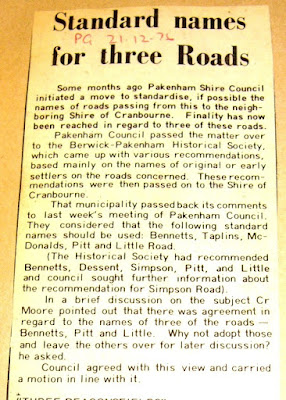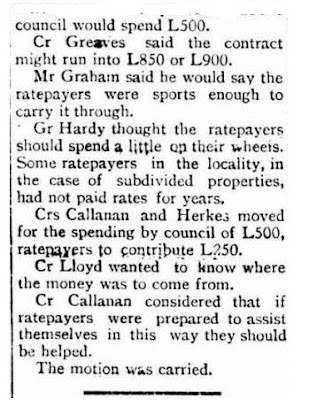Take a motoring trip around the Koo Wee Rup Swamp in 1929. From The Herald, July 18, 1929, see here.
Herald Tourist Bureau
Circuit of Koo-Wee-Rup Swamp
Day Outing of many attractions
(By our Special Motor Writer)
Though most tourists to Lang Lang and San Remo now travel by way of Pakenham and Koo-wee-rup on splendidly surfaced roads, much more attractive country is seen when the route followed is the old though fairly rough road from Dandenong to Lang Lang by way of Cranbourne and Tooradin.
The two roads combined provide an excellent triangular route for a one-day outing, and, though two or three short stretches of road in the hills near Cranbourne will be greasy after rain, the full route is passable in all weathers, and will be improved each week by the reconstruction now in progress.
Dandenong, 19. 6 miles from Melbourne, by the Prince's Highway, is the starting point for the tour. Setting the speedometer at zero at the Shire Hall, the town baths are passed first on the left, then the road to Frankston on the right, and at 1.0 mile speedometer reading turn right from the Prince's Highway, where a finger post directs to Cranbourne.
Watch the level crossing at 1.1. then follow the good asphalt road. Unfortunately it does not last for long. At 2.3 cross the Eumemmering Creek, where new irrigation works are being finalised; another creek bridge at 2.5, pass a road on the left at 3.1, and the main road becomes an earth formation at 3.2.
THROUGH BELTS OF BUSH
To here the country traversed is fairly flat and devoted mainly to grazing. Go left at the fork at 3.9, where a sign shows right to Lyndhurst and rolling country is entered crossed by belts of bush.Use care at 6.8. where the clay surface is tricky, if wet, and again on more clay at 7.3. Beyond the cross roads at 7.5 very fine pastoral country is entered, a feature being the splendid plantations of trees, which form windbreaks to the different holdings.
THROUGH BELTS OF BUSH
To here the country traversed is fairly flat and devoted mainly to grazing. Go left at the fork at 3.9, where a sign shows right to Lyndhurst and rolling country is entered crossed by belts of bush.Use care at 6.8. where the clay surface is tricky, if wet, and again on more clay at 7.3. Beyond the cross roads at 7.5 very fine pastoral country is entered, a feature being the splendid plantations of trees, which form windbreaks to the different holdings.
The road is pot-holed for a fairly long distance from here, but the side tracks will be found good. Another cross road is passed at 8.7, then Cranbourne railway station on the right. Cross the rail at 8.8, then follow the very pot-holed road through Cranbourne (two hotels) to the junction with the Clyde-Frankston road at 9.7. Keep straight on at the junction, the road entering scrub and bracken-covered country, while the first view of the distant Strezlecki ranges is obtained directly ahead.
MOUNTAIN TEA-TREE
Some sand pits are passed on the left, then a narrow gauge rail crossed, at 10.7, in a belt of the mountain tea-tree. At 11.3 there is a road on the right to Hastings, followed by a short patch of slippery road, then some new road construction works, where the road is unfinished and slippery. This going ends at 12.9 and at 13.1 a metal road begins, though in places the side tracks will be found more comfortable.
Five-Ways Junction is reached at 13.7, and at 13.9 (the fifth road) go half left, a finger post directing ahead to Devon Meadows and Cannons Creek. The road continues from there in fairly good condition, through gums and ti-tree, to the creek at 15.9, then through bracken country to an irrigtion bridge at 16.8. Pass the former Sherwood Hotel at 17.0. and fairly open farming country will be entered.
VIEW OF THE RANGES
Watch the turn over the creek at 18.0, and at 18.4 a splendid view will be obtained on the left of the Gippsland Ranges, snow-capped at this season. At 18. 6 the first head-water of Western Port is skirted, Tooradin P.O. is passed at 18. 7, then Tooradin Hotel, where a road runs left to the station, while a long railed bridge leads ahead over a picturesque inlet. Generally this is filled with a fleet of fishing craft and private yachts, and, eliminating the mangroves, has somewhat the appearance of a Norfolk Broad estuary.
The road enters particularly dense scrub at 19.5 - mainly Captain Cook ti-tree, though there are frequent growths of native cherry and white-blossomed shrubs. At 21.0 keep on where a road runs left to Dalmore. and thereafter keep Western Port on the right, the road running across flats, grown with mangrove and pierced at intervals with by creeks and salt water Inlets. These bridges are at 21.6. 22.1 (watch). 22.2, 22.4. 23.3, 23.4. and the road between them is specially well surfaced. This section of very flat country makes the distant ranges very noticeable, and they form a blue horizon on three sides.
DONKEYS GRAZING
At 24.0 keep on at the junction (left to Koo-Wee-Rup), and pass through splendid grazing country, here an occasional donkey may be seen grazing contentedly in a herd of cattle, or with lamb-companioned sheep.
MOUNTAIN TEA-TREE
Some sand pits are passed on the left, then a narrow gauge rail crossed, at 10.7, in a belt of the mountain tea-tree. At 11.3 there is a road on the right to Hastings, followed by a short patch of slippery road, then some new road construction works, where the road is unfinished and slippery. This going ends at 12.9 and at 13.1 a metal road begins, though in places the side tracks will be found more comfortable.
Five-Ways Junction is reached at 13.7, and at 13.9 (the fifth road) go half left, a finger post directing ahead to Devon Meadows and Cannons Creek. The road continues from there in fairly good condition, through gums and ti-tree, to the creek at 15.9, then through bracken country to an irrigtion bridge at 16.8. Pass the former Sherwood Hotel at 17.0. and fairly open farming country will be entered.
VIEW OF THE RANGES
Watch the turn over the creek at 18.0, and at 18.4 a splendid view will be obtained on the left of the Gippsland Ranges, snow-capped at this season. At 18. 6 the first head-water of Western Port is skirted, Tooradin P.O. is passed at 18. 7, then Tooradin Hotel, where a road runs left to the station, while a long railed bridge leads ahead over a picturesque inlet. Generally this is filled with a fleet of fishing craft and private yachts, and, eliminating the mangroves, has somewhat the appearance of a Norfolk Broad estuary.
The road enters particularly dense scrub at 19.5 - mainly Captain Cook ti-tree, though there are frequent growths of native cherry and white-blossomed shrubs. At 21.0 keep on where a road runs left to Dalmore. and thereafter keep Western Port on the right, the road running across flats, grown with mangrove and pierced at intervals with by creeks and salt water Inlets. These bridges are at 21.6. 22.1 (watch). 22.2, 22.4. 23.3, 23.4. and the road between them is specially well surfaced. This section of very flat country makes the distant ranges very noticeable, and they form a blue horizon on three sides.
DONKEYS GRAZING
At 24.0 keep on at the junction (left to Koo-Wee-Rup), and pass through splendid grazing country, here an occasional donkey may be seen grazing contentedly in a herd of cattle, or with lamb-companioned sheep.
At 25.6 a splendid road comes in on the left from Pakenham. This is the natural turning point for the route described, but for those who desire to see it there exists, three miles further on, and after passing a bridge under construction and crossing the Yalock Creek, probably the finest hawthorn hedge in the State. It is in splendid trim; now it is bearing a profuse growth of scarlet haws, and is three miles long. It ends in kangaroo wattle just before Lang Lang, where a cross road leads left to Drouin and right to Nyora by the South Gippsland Road, or to San Remo, Wonthaggi and Corinella.
Returning to 25.6 turn into the road to Pakenham. Right to the Prince's Highway this will be found to be excellently surfaced in all weathers. It leads first to a junction, at 26.8, where turn sharp right, then cross the rails at 26.9. turning sharp left, without entering Koo-Wee-Rup, where a finger post shows ahead to Bayles, Bunyip and Warragul and left to Pakenham.
MANY BRIDGES
There is a road on the right at 27.1, then a bridge at 27.5, followed immediately by a road on the right, a second bridge, then a cross road, and finally a big double bridge. Again, at 27.7 there is a road left, then another bridge, and a finger post to Pakenham, Pass the cross roads at 28.7 and another cross road at 30.8. To here the road skirts the Koo-Wee-Rup swamp, and is bordered by an earth works, with occasional private bridges as entrances to farms.
At 31.8 passed a road on the right, turn left over bridge, then turn right, leaving another road on the left. At 32.9 use caution in making the fairly sharp left turn, for a big unprotected ditch borders the road ahead. Pass a cross roads next and at the junction, at 33.9, turn left, pass Pakenham station, then cross the railway line and Pakenham East post office will be reached at 36.6.
Continuing on, Pakenham Junction will be reached at 37.2. where first keep on, then turn half left into the Prince's Highway. From there the road is splendid back to Dandenong (reached in 16.8 miles, or 54.0 miles total speedometer reading.
Progressive readings for this section are: — Officer (41.2), Beaconfield and Cardinia Creek (42), Berwick (45.5), Narre Warren (47.9) and Eumemmering Creek (52.3).
Returning to 25.6 turn into the road to Pakenham. Right to the Prince's Highway this will be found to be excellently surfaced in all weathers. It leads first to a junction, at 26.8, where turn sharp right, then cross the rails at 26.9. turning sharp left, without entering Koo-Wee-Rup, where a finger post shows ahead to Bayles, Bunyip and Warragul and left to Pakenham.
MANY BRIDGES
There is a road on the right at 27.1, then a bridge at 27.5, followed immediately by a road on the right, a second bridge, then a cross road, and finally a big double bridge. Again, at 27.7 there is a road left, then another bridge, and a finger post to Pakenham, Pass the cross roads at 28.7 and another cross road at 30.8. To here the road skirts the Koo-Wee-Rup swamp, and is bordered by an earth works, with occasional private bridges as entrances to farms.
At 31.8 passed a road on the right, turn left over bridge, then turn right, leaving another road on the left. At 32.9 use caution in making the fairly sharp left turn, for a big unprotected ditch borders the road ahead. Pass a cross roads next and at the junction, at 33.9, turn left, pass Pakenham station, then cross the railway line and Pakenham East post office will be reached at 36.6.
Continuing on, Pakenham Junction will be reached at 37.2. where first keep on, then turn half left into the Prince's Highway. From there the road is splendid back to Dandenong (reached in 16.8 miles, or 54.0 miles total speedometer reading.
Progressive readings for this section are: — Officer (41.2), Beaconfield and Cardinia Creek (42), Berwick (45.5), Narre Warren (47.9) and Eumemmering Creek (52.3).




